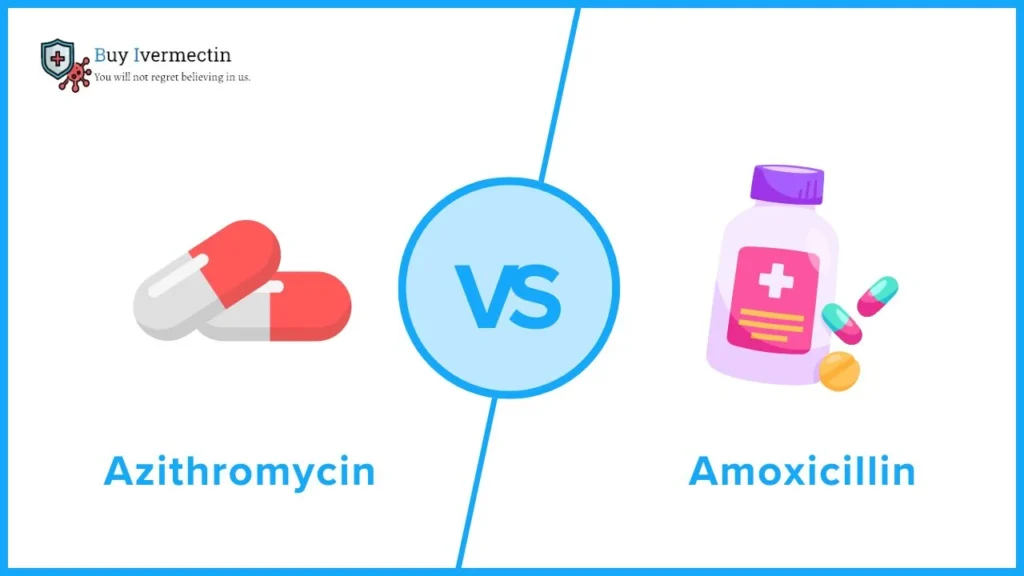Table of Contents
ToggleIntroduction
When it comes to antibiotics, Azithromycin Vs Amoxicillin are two of the most commonly prescribed medications. They are both used to treat a variety of bacterial infections, but they have different mechanisms of action, effectiveness, and side effects. This comprehensive guide will provide detailed information on Azithromycin and Amoxicillin, covering their uses, dosages, side effects, prices, and compositions to help you understand which one might be better suited for your specific needs.
What is Azithromycin?
Azithromycin is a macrolide antibiotic that fights bacteria in the body by inhibiting bacterial protein synthesis. It is effective against a broad range of bacteria and is commonly used to treat respiratory infections, skin infections, ear infections, and sexually transmitted diseases.
Uses of Azithromycin
- Respiratory Infections: Such as pneumonia, bronchitis, and sinusitis.
- Skin Infections: Including cellulitis and impetigo.
- Ear Infections: Otitis media.
- Sexually Transmitted Infections: Including chlamydia and gonorrhea.
- Throat Infections: Such as strep throat and tonsillitis.
What is Amoxicillin?
Amoxicillin is a penicillin-type antibiotic that works by inhibiting the formation of bacterial cell walls, leading to the death of the bacteria. It is widely used to treat various bacterial infections, including respiratory infections, urinary tract infections, and skin infections.
Uses of Amoxicillin
- Respiratory Infections: Including pneumonia, bronchitis, and sinusitis.
- Ear Infections: Otitis media.
- Throat Infections: Such as strep throat and tonsillitis.
- Urinary Tract Infections (UTIs): Bladder and kidney infections.
- Skin Infections: Including cellulitis and skin abscesses.
- Dental Infections: Such as abscesses and periodontitis.
Dosage and Administration
Azithromycin Dosage
- Adults: The typical dosage for adults is 500 mg on the first day, followed by 250 mg once daily for the next four days. For certain infections, such as sexually transmitted infections, a single dose of 1 gram may be prescribed.
- Children: The dosage for children is based on body weight and the type of infection being treated. The common dosage is 10 mg/kg on the first day, followed by 5 mg/kg once daily for the next four days.
Amoxicillin Dosage
- Adults: The usual dosage for adults is 500 mg to 875 mg every 8 to 12 hours, depending on the severity of the infection.
- Children: The dosage for children is typically 20 to 40 mg/kg per day, divided into three doses, depending on the type and severity of the infection.
Side Effects
Azithromycin Side Effects
Common side effects of Azithromycin include:
- Nausea
- Vomiting
- Diarrhea
- Stomach pain
- Headache
Less common but serious side effects include:
- Liver problems: Including jaundice and hepatitis.
- Allergic reactions: Such as rash, itching, and swelling.
- QT prolongation: A heart rhythm condition that can cause serious irregular heartbeats.
Amoxicillin Side Effects
Common side effects of Amoxicillin include:
- Nausea
- Vomiting
- Diarrhea
- Rash
Less common but serious side effects include:
- Allergic reactions: Such as anaphylaxis, which can be life-threatening.
- Clostridium difficile-associated diarrhea: Severe diarrhea caused by a bacterial infection.
- Liver damage: Including jaundice and hepatitis.
Price and Availability
Azithromycin Price
The cost of Azithromycin can vary based on the brand, dosage, and location. On average, a course of Azithromycin (500 mg on the first day, followed by 250 mg for four days) costs around $38.00 without insurance. Generic versions are typically less expensive.
Amoxicillin Price
Amoxicillin is generally less expensive than Azithromycin. A typical course of Amoxicillin (500 mg every 8 hours for 7 days) can cost around $50. without insurance. Generic versions are widely available and usually cost less.
Composition
Azithromycin Composition
Azithromycin is available in various forms, including tablets, capsules, and oral suspension. The active ingredient is Azithromycin dihydrate, and inactive ingredients may include:
- Microcrystalline Cellulose
- Pregelatinized Starch
- Sodium Lauryl Sulfate
- Magnesium Stearate
Amoxicillin Composition
Amoxicillin is available in tablets, capsules, and oral suspension forms. The active ingredient is Amoxicillin trihydrate, and inactive ingredients may include:
- Magnesium Stearate
- Microcrystalline Cellulose
- Colloidal Silicon Dioxide
- Croscarmellose Sodium
Which One is Better?
The choice between Azithromycin and Amoxicillin depends on several factors, including the type of infection, patient’s medical history, and potential drug interactions.
Efficacy
- Azithromycin: Often preferred for respiratory infections and sexually transmitted infections due to its broader spectrum of activity and longer half-life, which allows for shorter treatment durations.
- Amoxicillin: Typically more effective for ear infections, throat infections, and urinary tract infections. It is also widely used for dental infections.
Side Effects
- Azithromycin: Known for gastrointestinal side effects like nausea and diarrhea. It also carries a risk of QT prolongation, which can be dangerous for patients with certain heart conditions.
- Amoxicillin: Commonly causes gastrointestinal issues as well, but is also associated with a higher risk of allergic reactions, particularly in individuals with a penicillin allergy.
Cost
- Azithromycin: Generally more expensive than Amoxicillin, especially the branded versions.
- Amoxicillin: Typically less expensive and widely available in generic forms.
Conclusion
Both Azithromycin Vs Amoxicillin are effective antibiotics with specific uses, benefits, and drawbacks. Azithromycin is often chosen for its convenience in dosing and its efficacy in treating a broad range of infections. On the other hand, Amoxicillin is preferred for its effectiveness in treating specific infections like ear infections, throat infections, and urinary tract infections, and for its lower cost.
When deciding between the two, it’s essential to consult a healthcare provider who can consider your medical history, the type of infection, and potential drug interactions. By understanding the differences between Azithromycin Vs Amoxicillin, you can make an informed decision about which antibiotic is best suited for your needs.




